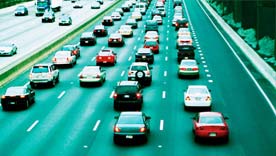I dunno, it kinda reminds me of the flying cars scenario that the media propogated in the 1960s. Where are all the flying cars?
Cars talking to cars
By: Tom Ripley
Date: Monday, 21. January 2008
As a driver, you have the responsibility to know and understand what the vehicles around you are doing and what threats they might pose to your safety. But in the future, your car might share that responsibility by sensing what other vehicles near yours are doing and giving you warnings that can help you respond to that information. And of course, beyond that, we might eventually see vehicles that assume the entire responsibility for dealing with other vehicles and the environment, while you sit back until you are delivered to your destination.
None of this is nearly as far into the future as you might imagine. In fact, many vehicle manufacturers are hard at work on technologies that can enable all the scenarios we outlined above. The technology could significantly mitigate heavy traffic problems as well. For instance, General Motors vehicles equipped with vehicle-to-vehicle technology can detect the position and movement of other vehicles around them whether they are in blind spots, stopped ahead on the highway but hidden from view, around a blind corner or blocked by other vehicles.
 Additionally, other vehicles will know where your vehicle is, too. With this "sixth sense" cars and trucks equipped with this technology can anticipate where other vehicles are up to a quarter of a mile away and can react to potentially hazardous driving situations. To help alert you to the possibility of dangerous incidents, the system can warn the driver with chimes, visual icons and seat vibrations. If the driver doesn't respond to the alerts, the vehicle can bring itself to a safe stop, avoiding a collision.
Additionally, other vehicles will know where your vehicle is, too. With this "sixth sense" cars and trucks equipped with this technology can anticipate where other vehicles are up to a quarter of a mile away and can react to potentially hazardous driving situations. To help alert you to the possibility of dangerous incidents, the system can warn the driver with chimes, visual icons and seat vibrations. If the driver doesn't respond to the alerts, the vehicle can bring itself to a safe stop, avoiding a collision.
The system in action seems almost magical. GM's V2V technology can warn the driver when a vehicle ahead, regardless of lane, is stopped, is traveling much slower than approaching cars or is braking hard, allowing the driver to brake or change lanes as needed. It also can activate rear lights to warn another driver when his or her approaching vehicle is moving too quickly toward your stopped or slower-moving car and a rear-end collision is imminent.
While many auto manufacturers are digging deep into these techniques, GM feels its unique advantage in this area is its ability to leverage or enhance existing driver-assistance systems such as OnStar and StabiliTrak to deliver solutions more quickly and cost effectively. The company says much of the technology that is a precursor to vehicle-to-vehicle communications exists today and that sophisticated V2V communications and safety systems could be on vehicles in five to 10 years.
Today, some state-of-the-art new luxury vehicles are equipped with multiple safety sensors, including a long-range scanning sensor for adaptive cruise control, forward-vision sensors for object detection, mid-range blind spot detection sensors and long-range lane-change-assist sensors. These systems might be included in or perhaps replaced by new-generation V2V systems, which could make the systems less costly and expand their use to less expensive vehicles.
For example, GM's experimental vehicle-to-vehicle (V2V) communications combines a simple antenna, a computer chip, and GPS (Global Positioning System) technology that allows vehicles to communicate their positions to each other. Equipped vehicles can detect other vehicles up to a quarter mile away (well beyond "line of sight") and then can communicate potentially dangerous situations to the drivers. One advisory sensor has the capability of providing all-around instantaneous traffic intelligence as well. This promises a better and significantly less-costly way of sensing other vehicles on or off the road.
How important is this? Consider this scenario: you get in your vehicle, tell it by voice command where you want to go, and it drives you there safely, using the most direct route taking into account traffic conditions and possible road construction delays. You might never put your hands on the steering wheel or your foot to the gas pedal. In addition to providing significantly better safety than today's vehicles and their human drivers, this could increase the vehicle-handling capabilities of our current roadway system, minimizing traffic snarls and even cutting the use of fuel. That's very smart, indeed.
--- Driving Today Contributing Editor Tom Ripley writes about the auto industry and the human condition from his home in Villeperce, France.
- Drivers.com -- articles and links on Communications
- Drivers.com article: A heads up on 2008 cars and driving
- Drivers.com article: Future car - telematics gains traction
Further comments to this article have been disabled.
All Comments (1)
Showing 1 - 1 comments
![]() Kevin,
Kevin,
